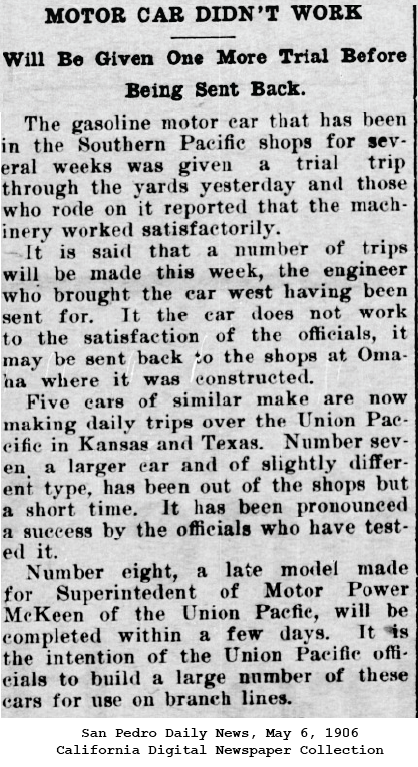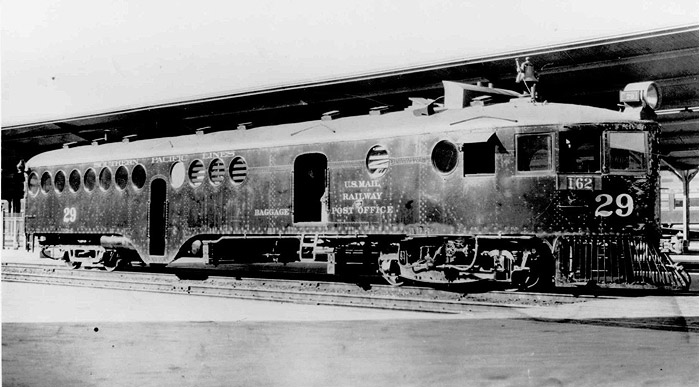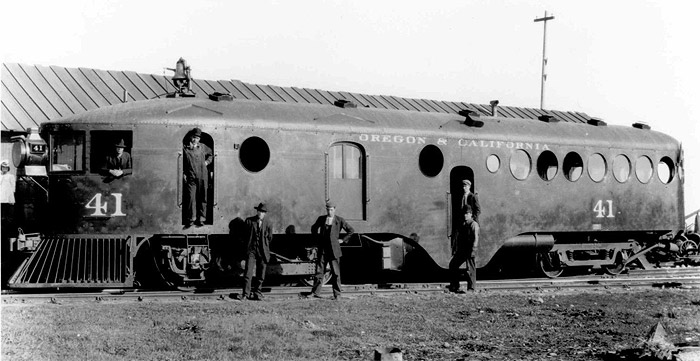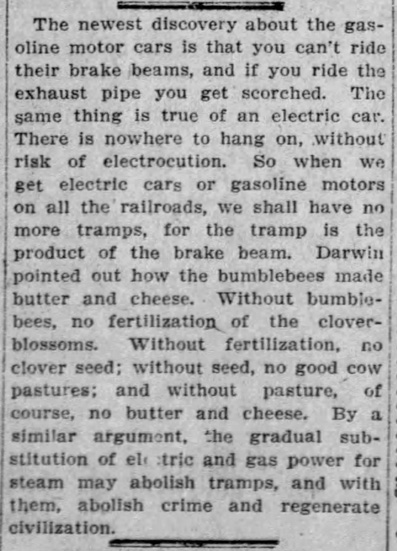|
|
|
Motor Car Mysteries
Motor Car Miscellany
Motor Car Documents
The McKeen Motor Car, 1956 manuscript by Stanley T. Borden PDF - Shasta Division Archives
SP McKeen Car Rosters
SP McKeen Car Trials & Tribulations (page)
|
"McKeen" Timetables
|
1909-09-20 Los Angeles & San
xxxxDiego Beach Ry.
1910-04-17 Salem, Falls City &
xxxxWestern.
1927-03-01 Lakeside & Marblehead
xxxxR.R.
|
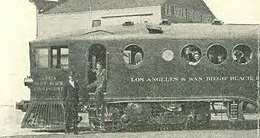 |
|
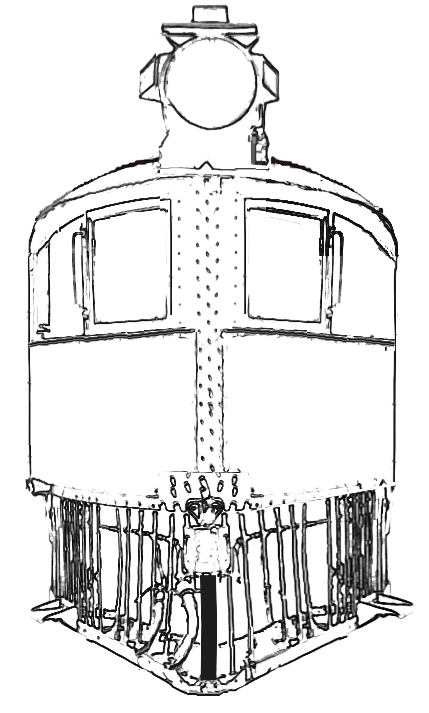
Anyone interested in SP's McKeen Cars should consult the extensive, illustrated article in Southern Pacific Technical & Historical Society's house organ, SP Trainline:
"Southern Pacific System McKeen Cars" by John R. Signor; SP Trainline issue #107, Spring 2011
Other reading: Wx4's content pales in comparison to Madison Kirkman's McKeen Historical Society website. Don Strack's excellent website, UtahRails.net, offers a large selection of motor car data, much of it copied from print media.
|
|
 5-23-24 update in BOLD
5-23-24 update in BOLD
|
| For a device that was once so common on Southern Pacific, it is a bit surprising that no definitive record has yet to surface about the exact color of its early Mckeen cars, or when they began to be repainted green.
While we know from old postcards that some cars were delivered in a color somewhere in the red-maroon spectrum, neither a paint formula or color samples have surfaced. In his 2011 SPH&TS Trainline article (see page top right) about SP Mckeen Cars, J.R. Signor speculated that the delivery color for the early cars was probably close to that of the Mckeen stationary letterhead displayed in the article, a medium-bright maroon color. But Mckeen letterheads came in at least three distinct versions, with the car color varying from dark to bright maroon. There also is the question of document aging's effect on color. Still, this clearly is a start.
Two telling, but not definitive, descriptions of the cars' color have come to light:
The first comes from a July 27, 1909 article, "Espee Motor Test", by an unknown Los Angeles Times reporter who described the car as "one of the latest Mckeen gasoline cars, painted a flaming red". Clearly, the cars were not clad in a somber shade of maroon. The postcard and letterhead at right both portray what might be considered as flaming red.
In his "McKittrick McKeen's" article for SP Trainline (issue #40, pg. 23; subsequently appearing in his History of the Sunset Railway), John F. Bergman cites an (unclearly attributed) source as saying that, "The McKeen #19, and #23 were both of the 55'6" (short) model and were painted a deep red (perhaps maroon) color, with green trucks and striped in gold." This is the only known reference to the red cars having (olive?) green trucks.
One shade-of-red/maroon possibility of indeterminate probability is C.S. 205-Red that appears in a period "Common Standard Colors for Maintenance of Way Department".

(Shasta Division Archives)
Note that several colors on the chart, including C.S. 11-Metallic also were adopted by the Motive Power Department in 1904. (Metallic was a freight car color not employed on any passenger equipment as far as we know.)
When did the red cars go green? Signor's article indicates surviving company records show repaints as early as 1910, but records are incomplete. Shasta Archives does have a 1928 lettering diagram (below) with notations that it was based upon a 11-14-1908 diagram, as revised on 1-29-1909, 4-30-1909 and 2-17-1913, but the body color is not specified. The 1909 LA Times article apparently referred to one of the #19 - #29 series turned out in March and April of that year, so one could validly speculate that the 4-30-1909 lettering diagram revision may pinpoint the date that SP changed the carbody color specification to green (what exact shade of green, we shall assiduously avoid). Certainly 1-29-09 was too early, given the clutch of cars delivered 1-2 months later, and by 2-17-1913 many cars were already green. Of course, the true significance of the 4-30 date is not known.
So, for the sake of argument, anyway, SP's early "flaming red" Mckeen Car color was gradually displaced by green after the appearance of the new 4-30-1909 spec. Contrary empirical evidence or deductive reasoning is always welcome.
|
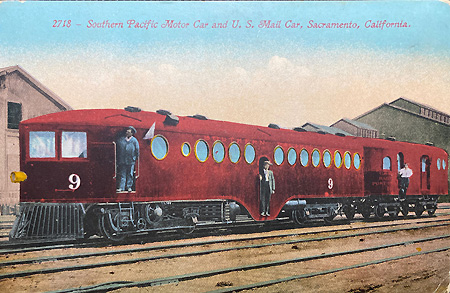
The 'flaming red' paint scheme shown in the ca.1909 Edward H. Mitchell postcard above, and the rough color equivalent exhibited in the Mckeen letterhead image below (with apologies, pirated from Don Strack's extensive Mckeen Car coverage at UtahRails.net) may not be far off the mark. Note that the postcard accurately portrays the large aluminium colored numbers, as well as the smaller gold colored "Southern Pacific" above the portholes, and even the brass headlight housing.
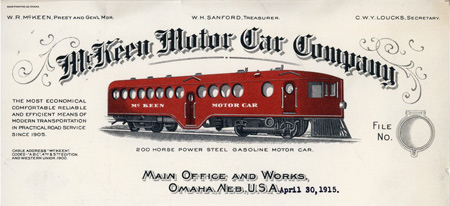

1928 SP Mckeen Car lettering diagrams - click on image
|
|
It's...
.........................................................
The Mckeen Motor Train!
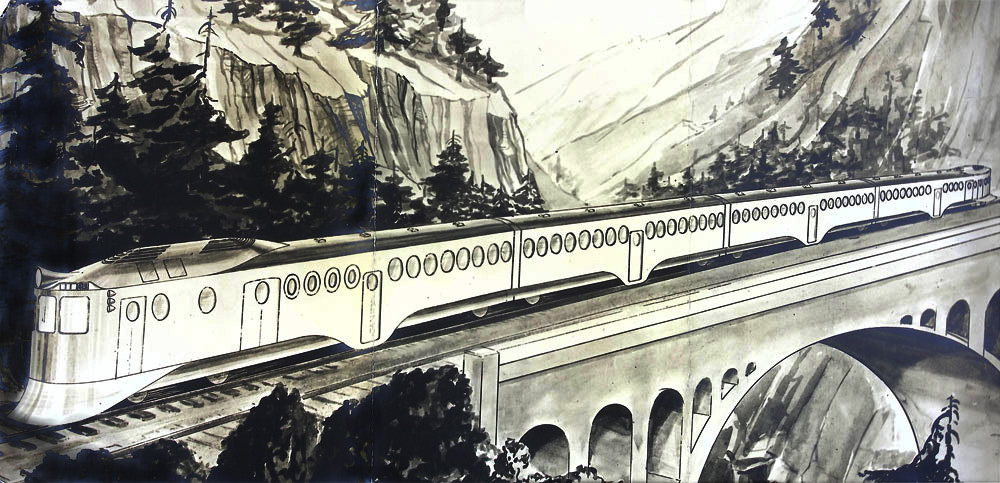
Fantabulous, isn't it? Staff knows nothing about this image's background: email wx4org@yahoo.com if you do.
scanned from an approximately 2 foot wide cardstock mage at Shasta Archives
|
a "short" Mckeen Car in its least-natural SP environment

The image above, taken from a glass plate negative produced by an unknown photographer, shows a "short" (≈ 55ft; "long" cars ≈ 70ft; see page bottom) Mckeen car during a brief moment of glory, running westward on Southern Pacific's "Cal-P" mainline through the former cow pastures of Pullman Park, on the then outskirts of Richmond, California. Such regularly scheduled forays on the busy line were conducted with a high element of risk, as SP still had not nearly ironed out all of the trouble-plagued Mckeen's mechanical foibles. Company officials likely came to realize their mistake in short order, causing them to withdraw the cars in favor of less demanding runs on more weed-grown track, where an inert motor car would make a more modest impact upon operations.
The photo likely dates to 1910, about the time that construction workers completed the new nearby Pullman Company repair shops. Next door, land speculators created Pullman Park (note the kiosk), a residential development conceived at a time when industrial workers, due to matters of time and economy, preferred to walk to work. This general frame of mind would last for about another five years, at which time the automotive age suddenly and unexpectedly burst forth, turning old predilections upside down.
New 9-29-22: What with Deoldify and other colorization programs being the latest thing, we thought that we would give this a whirl with the photo. Results: OK, but the program did not know what to do with the Mckeen, which remains gray. A different coloization program showed the kiosk sigh as white lettering on a red background.
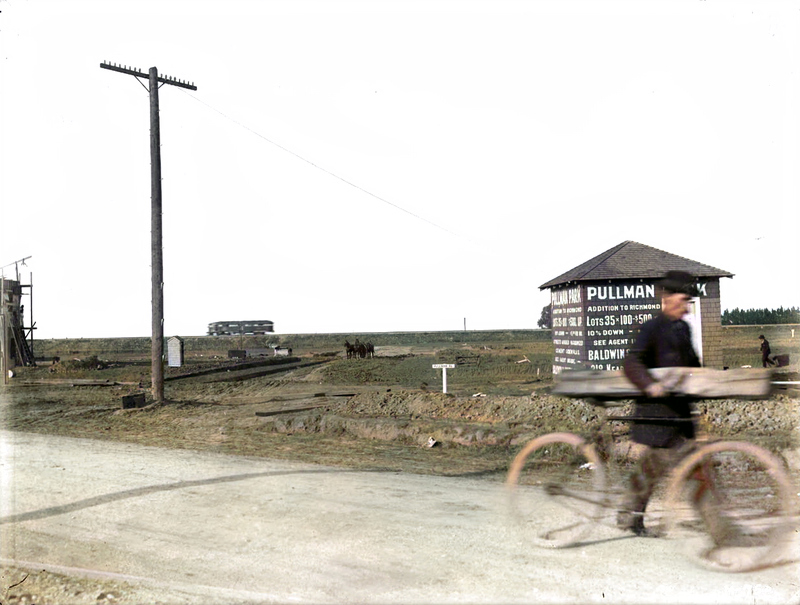
|
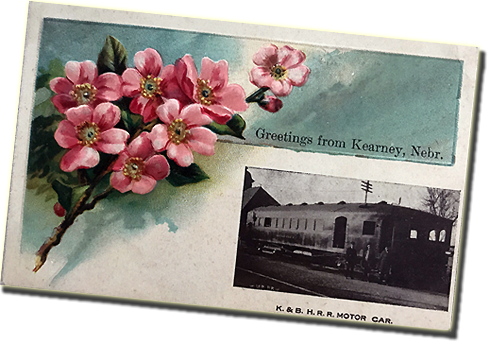
NEW 9-29-22: This 1907 postcard is a beauty - the flowers are embossed - even if the photo of an early UP Mckeen on its subsidiary Kearny & Black Hills Railroad is not the greatest. We suspect that the folks in Kearny ordered a stock card, to which custom elements were added, out of a European printer's catalog. We have been unable to find the maker, "PF", nor its presumed city of origin, "S", but we suspicion that the latter stands for Salzberg.
|
|
|
|
conflicting directions
At the same time SP was acquiring Mckeens, it was busily (and in hindsight, ill-advisedly) constructing the new suburban electric systems in the Oakland, Portland and Los Angeles (Pacific Electric) areas that would displace a great number of short Mckeen cars from the runs for which they were best-suited. Worse for the shorter "wind-splitters", the United States Post Office Department instituted a new Parcel Post package delivery system in 1913, and it boomed virtually overnight. This overly-taxed the ability of the baggage-section-less short cars to haul both passengers and packages. Though the 200hp cars theoretically were capable of hauling a trailing car on level, dry rail, this arrangement was almost immediately found to come at a high cost to schedule time, even when the slippery-footed cars were operating on clear, level rail. Many motor routes subsequently reverted to standard steam-powered service due to a shortage of baggage section equipped 70 foot Mckeens.
Consequently, throughout the years leading up to the end of World War I, SP's 55 foot Mckeens were motors in search of a job. By then, most of the mechanical issues had been resolved, which along with conversion to distillate fuel, had made them much more economical and dependable to dispatch. Upon the close of United States Railway Administration control following the war, SP officials took a long, critical look at their local and branchline passenger services. Ten years before, these trains had formed the backbone of company earnings, but now many of them had seen their ridership evaporate from the effects of the private automobile and unregulated, competing auto stages.
The result was the first of SP's periodic purges of local / branch trains that essentially put the majority of the 55' Mckeens out to pasture in 1920. Three subsidiary Arizona Eastern cars managed to stay on the roster until mid-1929, perhaps in anticipation of the second wave of gas-electric cars that arrived from Brill and Pullman / Electro Motive early the next year. A few of the long cars survived in service in ever-decreasing numbers until the last one tied up from Placerville Branch duities in 1939, by which time SP was ready to yank the plug on motor cars altogether.
|
the short and the long of it
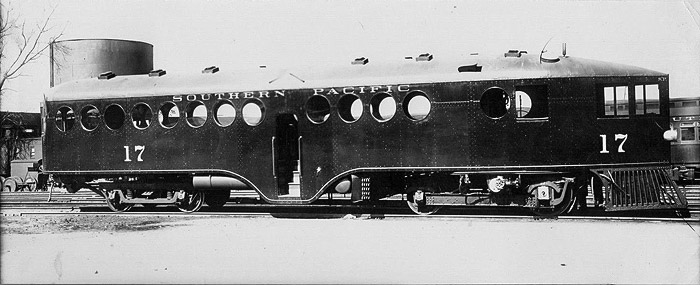
Most of Southern Pacific's McKeen Cars came in either of two styles: 1) nominally 55 feet long with no baggage section, and 2) nominally 70 feet long with a baggage section and doors. The longer cars generally were built later, after SP realized the need for a baggage section on branch lines, particularly after the inauguration of Parcel Post in 1913. Three cars, numbers 27, 29 and 31, were lengthened from 55 ft. to 70 ft. in 1917 because of this. Beginning with #43 in 1910, all new SP-proper cars were constructed to the longer dimension, but its subsidiaries continued purchasing short cars, some configured with baggage sections, some without. Presumably the subsidiaries bought short cars because the 70 footers were too long for their turntables.
Photos:
- (above) 55 ft. car #17 w/o baggage section: This appears to show the car when it was delivered to Sacramento to be set up in 1908. photographer unknown
- (below) 70 ft. car #29; Here we see her ready to depart Sacramento on the Placerville passenger in 1930. The Placerville run was the last regular assignment for SP Mckeens at the end of the decade. photographer unknown
- (2nd below) subsidiary O & C 55 foot car #41, later SP #41: The combination of a baggage section larger than some 70 cars, plus a short wheel base, may have been the reason that this car had outlived all of the other short cars by at least seven years when it was finally withdrawn in 1936. The photo, purportedly taken at Sacramento, shows an early headlight adaptation, perhaps about 1910. photographer unknown
|
Sacramento Union, 9-29-1908

|
|
|
|
Mckeen Motor Cars and the furthering of civilization
We at Wx4 are obviously great Mckeen fans, in part because they allowed Southern Pacific to expand its local passenger train service geometrically in the few years following 1908 - no matter that Mckeens were essentially the gasoline powered version of the electric interurban car - and we all know how interurban railways fared.
Before their rubber-tired nemeses quickly confined Mckeen cars to the dust heap, many people thought that the motors showed enormous potential, even to the point of contemplating them as agents for the salvation of civilization. Sadly (or thankfully, for tramps), the Mckeens never really had much of a chance to demonstrate their potential in that regard.
|
NEW 6-11-2024: One Messy Mckeen Move
The poor crew of SP McKeen #37 likely was already having a bad day when the car derailed while backing into the Gold Leaf Mining Company's spur at Middle Creek, roughly three miles north (RR east) of Redding.
We believe that Train #520 was a Sacramento-Chico motor run that SP briefly extended up to the booming copper town of Kennett commencing on April Fools Day, 1910. (Unfortunately, we have not located a timetable schedule for this run, nor do we know its longevity.)
That #37 was in the process of backing into a mining spur - and not Middle Creek's 18 car siding - only three miles out of Redding is about all we need to figure that the car was experiencing mechanical difficulties. Perhpas even, it may have conked out further up the line and coasted back to the siding. Alternately, perhaps Middle Creek siding was blocked with freight cars, and in those less particular days of where a passenger train could legally go into the hole, the crew elected to use the spur as a meeting point. Whatever the case, the derailment certainly produced a classic jackpot that evidently blocked the main track for an extended period.
We almost can hear the super's outpouring of epithets upon receiving the news and wonder if this incident directly led to the motor run's subsequent retrenchment back to Chico. |
|
|
|
|

